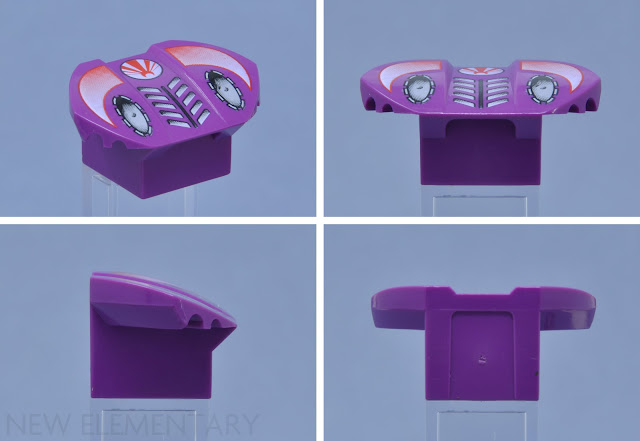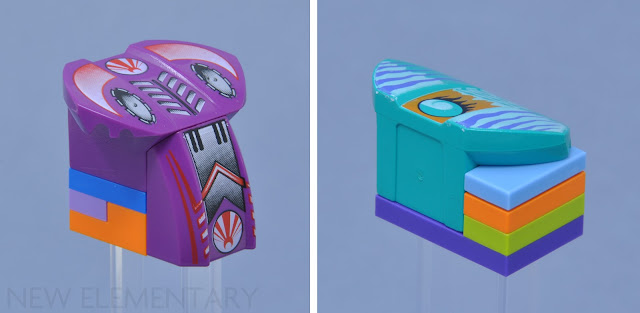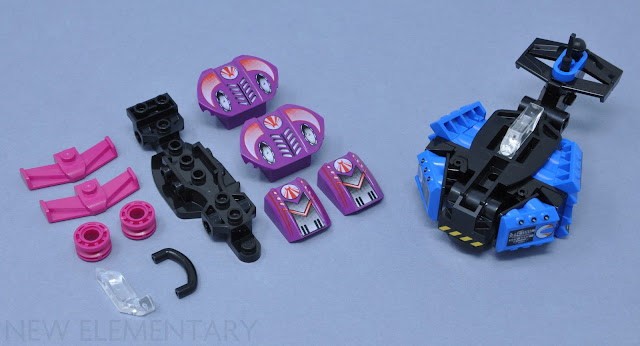Thanks to an insightful comment from Darmetricus on one of our previous articles, today we're venturing to planet Xalax for a look at the otherworldly elements produced for this short-lived but well-loved subtheme of LEGO® Racers in 2001.
This article contains affiliate links to LEGO.com; we may get a small commission if you purchase.

Crash 'Em Racers, better known as Xalax, was based on a simple premise: What if LEGO did Racers... but in space?
Assembling a Xalax car takes a matter of seconds as there's only four parts per vehicle: a base with wheels, a front body piece, rear body piece and the driver.
Most sets also included a launcher (
30556) which is worthy of analysis, but for today's article we'll just be focused on what makes the diddy cars themselves tick.
The elements
Instead of minifigures, the planet Xalax is populated by competitive alien drivers called Ramas.
Two moulds were created for the Ramas: Brick, Modified 2 x 2 Racer Driver Round Square (
30599, left) and Brick, Modified 2 x 2 Racer Driver Round Head (
30598, right). They were released in a wide range of colours, each with unique prints to depict the various racers.
Both moulds have a curious square notch at the base that has us stumped here at New Elementary. It doesn't seem to serve any purpose in the theme's intended play pattern (see images below). Perhaps it's a relic of some action feature that was dropped?
Unlike most LEGO Racers chassis, the Xalax vehicle base (
30558) doesn't feature a pull-back or flywheel mechanism to propel the car forwards. Instead there's a violent eject function triggered by the grey bumper which can be positioned front or back, depending on how you orientate the car's body parts.
The vehicle base reminds me of the promotional tie-in 'cereal cars' - although thankfully the plastic quality here is up to regular LEGO standard, not the cheap stuff. See
PaulvilleMOC's Forbidden Elementary article on those abominations – if you dare.
The body parts do the heavy lifting in making each racer unique. Two nose and two rear wing moulds are mixed and matched across the theme – each one with a exclusive print.
The fronts and backs are colour-coordinated for each vehicle to maintain a coherent livery – though mixing things up is always encouraged. There are 18 variations in total, and of course one of them is inexplicably expensive so my collection will remain incomplete for now.
Let's take a closer look at each pair of moulds in turn.
Slope 2 x 2 No Studs, with 3 Side Pistons Raised Edges (
30603) is one of Xalax's (partial) success stories. Introduced for the theme in 2001, it continued to appear in sets until its eventual retirement in 2008.
Its big brother wasn't so lucky:
Brick Sloped 2 x 2 No Studs with Angled Side Block Extensions (
30601) only ever appeared in Xalax sets and has never officially been released unprinted – hence why searching its mould number will mainly give you photos of a Scooby-Doo polybag!
Slope Curved 2 x 2 with Lip, No Studs (
30602) is the only Xalax element still in production – appearing in well over 500 sets so far, in 36 colours. What a fun origin story for a part that's now so prevalent!
Several mould variations have existed over the years but the only noticeable change is the removal of the trapezoid recess on the back face, which seems to have happened in 2017 to transparent versions (
28659) and then, from 2022, opaque parts (which TLG initially numbered as
4973, but confusingly then started using the original ID
30602).
Like the previous pair, this slope's larger counterpart also didn't fare so well:
Brick Curved 2 x 2 x 1 with Wings (
30600) was never used outside of the theme and therefore was also discontinued in 2001.
It's a shame the two bigger siblings didn't stick around longer because they're both fun detail pieces that surely had more life left in them. However, just because most of these parts aren't produced anymore doesn't mean they're obsolete; let's see what they can do.
Geometry and techniques
The angle ratio of part 30603 – 2 plates gained over 2 modules – matches the 1 x 6 Technic slope (
2744, 28670). It's an incline seldom seen in LEGO geometry, and one that came in handy for my
Fractal 45 spaceship.
Since its big brother 30601 shares the same angle, the two can be combined into one continuous textured slope – how satisfying! Staggering duplicates of both element looks good too, as does placing either one back to back with the 2x2 curved slope. There's so many shared characteristics in this little family of parts.
The underside of 30601 is similar to that of the 2x2 plate with grills (
41862) which was introduced only a year later in 2002. The side extensions of 30601 sit one plate above the base, allowing a tile to sit flush beneath the lower end. Its smaller counterpart can just about nest under the side extensions too – although the placement feels a little too snug to be legal.
Combining a few around a core of SNOT is quite a neat effect - spaceship engine greeble perhaps?
Handily, the extended front edge of 30602 clears adjacent studs, and its cut edges line up with 45° inverted slopes. Its outer curve radius is intriguing since it matches, but predates, any member of the 1x2 curved slope family by several years. All this inter-element synergy is possibly why it's stuck around in the LEGO inventory.
Anyone familiar with this element likely knows you can make a quarter curve with a pair of them by marrying up the 45° edges. This was even more useful in the years before the plethora of curved bricks we now enjoy were introduced.
However, it was news to me at least that the same trick works in conjunction with its big brother; thanks again Darmetricus! The side extensions of 30600 project outwards by exactly 1 module and sit a full brick away from the base – though a tile is still needed, since it lacks stud notches.
A more perplexing feature of 30600 is the front wall, which seems to be a fraction thicker than that of a standard brick. It prevents parts from being placed directly in front, which tragically means you can't place the smaller 2x2 slope underneath – even though it looks like it should be a perfect fit.
You can get some mileage with elaborate means like this technique above which uses bars and 1x1 Technic axle hole bricks, but I think the gymnastics required detracts from the combo's cool factor. Perhaps these quirks were a factor in the decision to discontinue all but one of the moulds?
Legacy
Xalax's smaller 2x2 slopes fit right in alongside similar vehicle elements, past and present. Note also the subtle 'Xalaxisms' above right: the piston pattern and rounded anti-stud tubes on parts
44675 (yellow) &
50943 (light bluish grey).
A spiritual successor to the Ramas was introduced in 2002: Racer Driver, Brick Special 2 x 2 No Head (
41850). The compact driver's body only saw use in 20 sets, before disappearing a year later. Nevertheless it remains a fun, if short-lived, mark of Xalax's legacy.
The recent series
71049 F1® Collectible Race Cars is a fun comparison. Just like the Xalax cars, they each feature unique prints, specialised moulds and slightly creepy-looking drivers.
Let's take a step further and see what happens when Xalax meets F1.
Tom's spaceship racer MOCs
Finding a shape that would work for both pairs of Xalax body elements took me some time.
Inspiration eventually struck when I flipped the F1 chassis upside-down to make good use of its abundance of connection points.
A rear view shows a few more of the mini-F1 parts that made it into the mix: wheels for engines, a pair of front wings for rear stabilisers, and driver halos repurposed as underslung cables.
Here's all the seed parts nicely organised. That F1 chassis definitely needs further examination, but that'll have to wait for a future article.
I hope you enjoyed this Old Elementary rabbit hole. Let us know of any others you think we should dive down next!
READ MORE: Review: 10357 Shelby Cobra 427 S/C from LEGO® Icons
Help New Elementary keep publishing articles like this. Become a Patron!
A huge thank you to all our patrons for your support, especially our 'Vibrant Coral' tier: London AFOLs, Antonio Serra, Beyond the Brick,
Huw Millington, Dave Schefcik, David and Breda Fennell, Gerald Lasser, Baixo LMmodels, Sue Ann Barber and Trevor Clark, Markus Rollbühler, Elspeth De Montes, Megan Lum, Andy Price, Chuck Hagenbuch, Jf, Wayne R. Tyler, Daniel Church, Lukas Kurth (StoneWars), Timo Luehnen, Chris Wight, Jonathan Breidert, Brick Owl, BrickCats, Erin and Dale, Thunderdave, Jake Forbes and our newest top-tier patron, H.Y. Leung! You folks are better than inverted cheese slopes.
All text and images are ©2025 New Elementary unless otherwise attributed.



























Niche analysis like this is why I love New Elementary
ReplyDeleteThanks Craig! Great job by Tom :)
Deletehell yeah
ReplyDeleteThe little gap in the body part is possibly an air gap? To make sure the figure releases cleanly and flys off further when the bumper is hit? Or possibly to provide a bit of flexibility to what is otherwise quite a thin plastic wall. Or maybe some hangover from the molding process (since these were probably conceived as limited-run parts)
ReplyDeleteYeah, could definitely be an air gap to prevent suction so it pops off easily, good idea.
DeleteWow, this article is better than I could have imagined! At this point, it's probably no secret that I love these designs, but you still brought several facts to light that I had never noticed before. I didn't know that the trapezoidal recess on opaque 30602 were removed and then reintroduced, and it's so cool to discover that 30602 also lines up with the baby-bow, several years apart, even! The article also reminds me of my childhood. I had forgotten how devastated I was when I found out that 30600's thicker wall prevented nesting! Your decision to mash these up with the F1 collectibles was ingenious. I had, until now, mostly overlooked them. I also was pretty content with my mostly complete collection of racers, but seeing what you did with doubles of each piece leads me to believe that I may want to double my collection. :) Thanks so much for another amazing edition of Old Elementary!
ReplyDeleteRe " the trapezoidal recess on opaque 30602 were removed and then reintroduced” – ahead of, this was poor editing my me (Tim). It was not reintroduced… what I meant to say was that it seems TLG used Design ID 4973 for the first colour of the version without a recess (black), but reverted to the original ID 30602 thereafter even though the recess was gone.
DeleteAhh, that does make more sense. I just confirmed for myself on Cole's Titan Dragon Mech's toes (which uses a technique discussed here). RIP trapezoidal recesses. :'(
DeleteI love when "specialized" molds end up becoming such staples of the system. My (biased) favorite example is the Bohrok eye piece, which has been in hundreds of sets since its introduction despite most of the Bohrok's other pieces being so specific to their wave they saw little to no use otherwise.
ReplyDeleteI agree! Not quite the same, but I feel like the big "Porsche bows" would never have happened without the Icons Porsche 911, and they have been used lots of other places.
DeleteThe thicker wall is incredibly frustrating, was it done to improve rigidity?
ReplyDeleteActually the drivers could have also used some spotlight, they are incredibly charismatic fellas and would also make a great series of MOCs tailored to their design.
Speaking of the elusive Ghost set, if one can live without the driver it is still possible to assemble the car piece by piece from BL without breaking the bank. Not for long though, I suppose.
Glad to see someone pointing out the similarity of the collectible pocket F1 cars to the Xalax Racers and the micro Drome Racers. I love to look at such parallels and analyse how Lego changed its ways through that last quarter of decade.
ReplyDelete